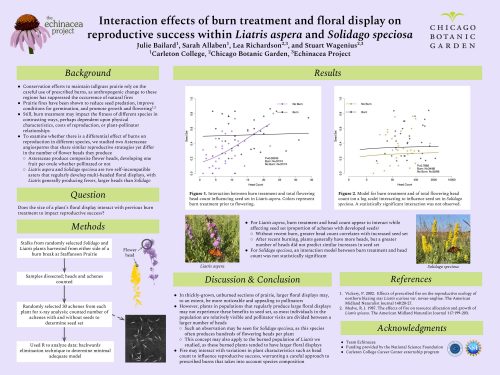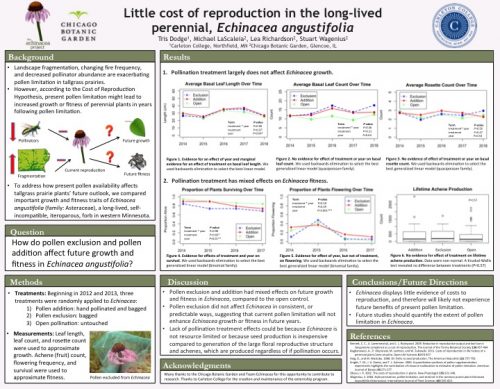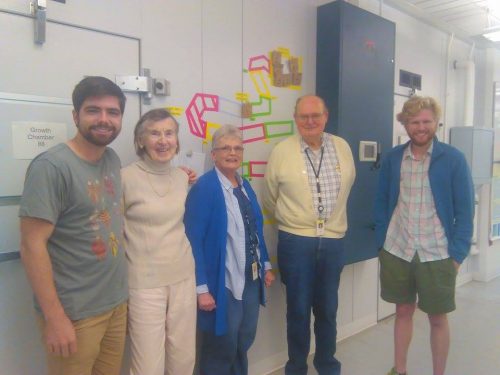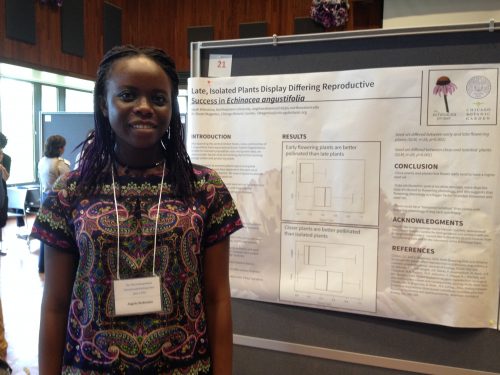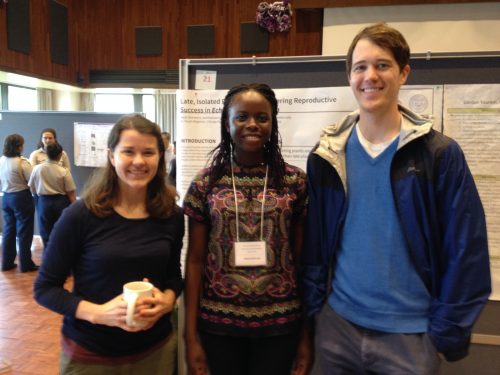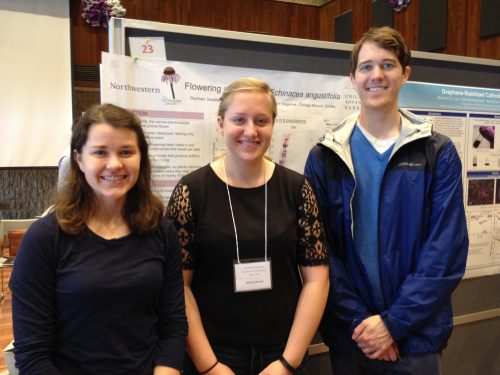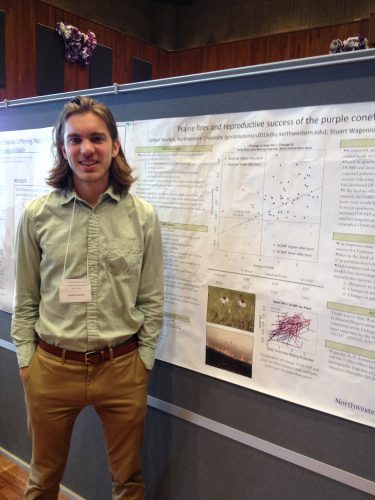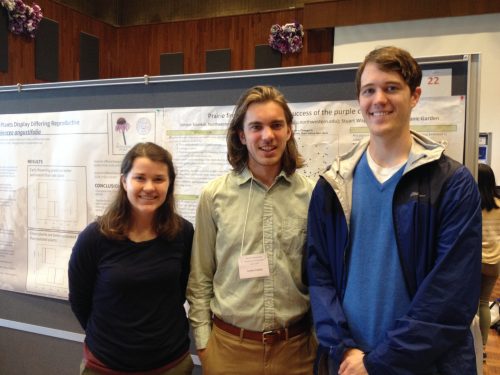|
|
Hello flog, one last time!
Today marks the end of my three weeks here on Team Echinacea, and I’m certainly sad to say goodbye! Nevertheless, it was exciting and rewarding to culminate this externship with a week of data analysis, poster creation, and presentation of findings to the team. While Tris chose to analyze data from Michael’s Echinacea pollen limitation experiment, Julie and I decided to delve into the worlds of Liatris aspera and Solidago speciosa, two other Asteraceae common to prairie ecosystems. Lea has been working with these species for her PhD project over the past few years, studying how timing and location of flowering influences reproductive success, so she was a great help as we commenced our analysis!
After having meticulously cleaned, counted, and classified innumerable Solidago and Liatris flowering heads, Julie and I wondered how the vast differences in head count between these two species may impact each plant’s fecundity (when Liatris plants generally have 10-20 heads, and many Solidago plants have hundreds or even thousands) . Further, knowing that human populations have largely suppressed the occurrence of natural fires in today’s prairies, we were also interested in analyzing the effects of prescribed burns on these common prairie species. We put these two questions together in our data analysis by forming a statistical interaction model–one in which the effect of fire would interact with the effect of flowering head count to influence reproductive success–and fitting it to our Liatris and Solidago data. Interestingly, we did not uncover the same results for these two closely-related plants! For Liatris, the interaction model was highly supported by our data: the head count of plants seemed to have more effect on seed set (a measure of fecundity) in plants that had not been recently burned than in plants that had been recently burned. Yet, for Solidago, this pattern was not present. Our findings suggest that prairie management strategies, of which prescribed burns are an integral part, should carefully consider the species composition of a prairie before burning, because different species may react to burn treatment in different ways. Check out our poster, attached here, for a more detailed analysis, as well as plots of our models!
Before I sign off, I want to send a huge ‘thank you’ to every member of Team Echinacea! This opportunity was incredibly influential for me–this was my first real research experience, and I learned so much about ecology, networking, career paths, data collection, statistics, and more. I had an amazing time, and I hope to see some team members again someday!
Thank you again,
Sarah

PDF version below:
Soliatris2018 Poster
Hi flog,
Wow! These last three weeks passed by super quickly! While the first two weeks were focused on seed cleaning, seed counting, and x-raying, we spent this past week on our independent projects. But that’s not to say this week was easy! In the past 5 days, I wrote exactly 900 lines of code in R to generate the figures and perform the analyses.
To get at how current pollen limitation affects Echinacea growth and future fitness, I performed analyses testing differences in plant traits between pollen exclusion, pollen addition, and open pollination treatments. I did not find evidence that pollination treatment affected either growth or fitness, which indicates that current pollen limitation will not benefit Echinacea in the future. This could be because Echinacea is not resource limited or because the cost of seed production is negligible.
Many thanks to the members of Team Echinacea who helped guide me through this process and made working in the lab such a pleasure!

Tris
Link to Poster
Hey Flog readers, Sam here.
After a quarter of hard work, all of the achenes from my thirty-two flowerheads have been counted, x-rayed, and classified! I am looking forward to analyzing the data next quarter in R through a class Stuart teaches at Northwestern. It’s been quite a journey learning about both the nitty-gritty of going from flower head to data sheet and the conservation biology through which we contextualize our data. Special thanks to Stuart for giving me the opportunity to intern for the Echinacea project, to Amy and Scott for being wonderful, helpful mentors, and to everyone else in the lab for your amazing company and support. If anyone reading this would like to know more about what it is like to intern for the Echinacea Project, feel free to e-mail me at Samuelhamilton2017@u.northwestern.edu.
Best,
Sam
Hey again Flog,
My name is Sam Hamilton and this is my second post on the Flog. In my first post, I focused on the experimental goals of the SppBonus project, the kind of data we are measuring, and the project’s relevance to understanding reproductive success in fragmented prairie remnants. Today, I will talk about the progress I’ve made, and the methods I’ve used to move this project from seed head to data set.
The first step of this project was to extract the achenes from the seed heads. Flowers of the Aster family, including Echinacea, are compound flowers, many flowers that grow together to look like one large flower. In Echinacea, each of these flowers, regardless of whether it is pollinated or not, produces a fruit called an achene. By measuring how many achenes contain seeds, we can estimate how well a flower was pollinated in a given year. Thus, in a project like SppBonus, the first step is to extract the seeds from the seed head. The SppBonus data set contained 32 different seed heads, which took me roughly a month to completely clean and organize into samples taken from the top, middle, and bottom of each flower.
The second step is to scan all the gathered achenes so that we can count the total number of achenes. This is an important metric to measure the reproductive fitness of each Echinacea plant. This was a fairly fast process and it only took me three days to scan the achenes from each seed head.
The third step is randomization. We ultimately determine whether or not an achene contains a seed by X-ray. However, there are simply too many seeds to X-ray them all efficiently. Thus, we take a sample from our seeds, X-ray those, and then use that data to make assumptions about the seed set as a whole. We randomize our samples, to ensure our samples are representative of their populations. Without this step, we risk choosing achenes that are the easiest to count, or best fit our expectations of what the data will look like. Our randomization procedure involves pouring the seeds onto a grid where each cell is assigned a letter and a number. A second sheet has these letter and number combinations in a random order and we go down the list selecting from each cell until we’ve collected thirty achenes total. This is the part of the project I’m working on now!
When not working on SppBonus, I am spending my time reading and discussing papers about fire and its effects on pollination and germination with Stuart, Amy, and Scott. I learn a lot from listening, and it’s always interesting to hear their insights into the merits and flaws of each paper, as well as to watch them design new experiments from the ground up.
Hopefully I didn’t bore you, until next time!
Sam
Hey Flog!
My name is Sam Hamilton, and I am a Northwestern senior doing research in the Echinacea Project lab this quarter. My project specifically seeks to understand the relationship between prairie fires and reproductive success of flowering plants using our model organism A. Echinacea. This is an important relationship to understand because, while historically fires were an integral part of the prairie life cycle, today’s isolated prairie remnants are often never burned. This could have a large impact on the success of shorter plants that rely on the extra sunlight and nutrients that a burn year supplies to flower and germinate. This quarter, I will be collecting the data from seed heads collected this year and analyzing it along with data collected in previous years to draw my conclusions.
I am also looking at the reproductive success of Echinacea flowers collected from the bottom, middle, and top of each head. In Echinacea, flowers mature first at the bottom and slowly develop towards the top over time. This allows us us to deduce when a plant was pollinated best during the season. I’ve been hard at work the past month cleaning seed heads and separating their achenes into top, middle, and bottom sections for later analysis. It’s been a lot of work, but the great company has kept it fun!
Until next time!
-Sam

Myself with Susie, Char, Aldo, and Scott. (Left to Right)

One month of cleaned and organized achenes.
Today we visited the rather small and flat NNWLF Site. This plot is just off the road and shows signs of disturbance from cars. The site is interesting because of the nearby pine trees which are not native to prairies. Pine trees could create a shadow over the remnant in the early morning because of their eastern position, this could impact the growth of plants. The outer edges of the plot contained non native sweet clover and alfalfa, which are legumes, and cool weather grass, brome. On the other hand, the core of the remnant contained mostly native milkweed and few non natives. There were no Echinacea buds yet as it is early in the season.
 North of Northwest of Landfill Site
Sarah presented her poster, “Late, Isolated Plants Display Differing Reproductive Success in Echinacea angustifolia” at the Northwestern Undergraduate Research and Arts Exposition. Here are some pictures from the event and her poster, which you can find here.
 
Rachael presented her poster, “Flowering schedules of Echinacea angustifolia” at the Northwestern Undergraduate Research and Arts Exposition. Here are some pictures from the event and her poster, which you can find here.
 
Gordon presented his poster, “Prairie fires and reproductive success of the purple coneflower” at the Northwestern Undergraduate Research and Arts Exposition. Here are some pictures from the event and his poster, which you can find here.
 
Synchrony between plants is important as higher synchrony with other plants leads to more potential pollen sources and a greater likelihood of a seed being pollinated and becoming viable. At this point, synchrony is measured by counting the number of nearby flowering echinacea plants, but my malo curve data allows us to measure synchrony using the number of florets open on a given day for the entire population and comparing it to the number of florets for a given plant. As shown by the graph below, measuring synchrony by counting the number of flowering plants can overestimate synchrony later in the season when flowering plants have less open florets. Time to explore these graphs for different populations and look at the potential impacts.

|
|
